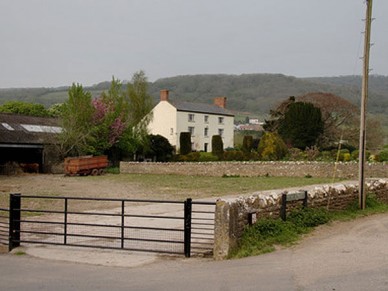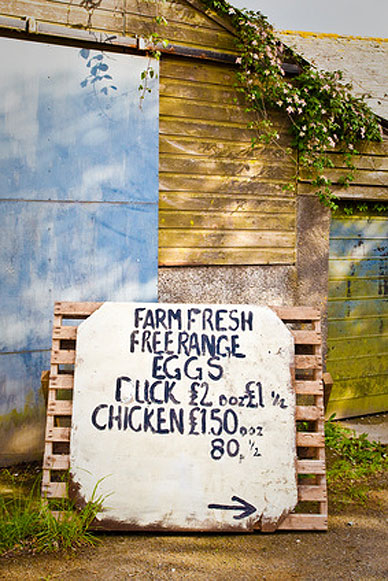Pocket Farm's guide to buying a USABLE smallholding

Buying any property can be stressful and smallholdings or other small commercial agricultural sites are no exception. If you are looking for somewhere to grow produce, keep livestock or practice your craft, whether personally or as a business, there are additional questions you may need to ask to avoid making strategic or financial mistakes. This guide is designed as a checklist for the process and we have come up with a rather natty acronym USABLE to help you remember the main considerations when searching for your ideal slice of green.
Here’s how it’s derived – not necessarily in order of importance:
Utilities
Soil
Access and Location
Buildings
Land & Livestock
Effort
We would always recommend that you employ the services of a specialist agricultural surveyor but we hope that this summary can put some science behind compiling your shortlist and ultimately help to avoid the pitfalls of the agricultural property market.
Utilities
Most rural or remote properties these days will have a mains electricity supply of some description but this is not always the case for water, sewerage and gas. Find out how your property is connected to utilities and look at the running costs of any alternative provisions in place such as oil fired heating, a wood or coal fired range, solar panels, septic tank for sewerage or a borehole well for water. Some alternatives may well be cheaper but can also be less convenient or reliable so you’ll need to decide if you can live with them as connecting to the main utilities suppliers can be prohibitively expensive. Also check the availability of telephone (mobile and landline) and internet services at the site as this is an increasingly important form of communication these days whether you are using social media, Skype or email. Many of the forms used for livestock movements and other purposes are moving online too so you may well need a reliable connection to keep your paperwork in order.
Soil
If you are looking to grow produce for your own use, as a business or for animal fodder this is a big consideration. Most edible plants prefer a mildly acidic soil at a PH of about 6-6.5. If you are only cultivating a small area PH slightly outside of this range can usually be remedied fairly easily but on a larger scale it can be much more difficult especially if it is on the alkali side. You also need to ascertain the general texture of the soil as this will affect the ability to cultivate it in different ways. Sandy soils drain quickly and may be nutrient deficient whilst clays will retain water when wet but become hard and crack when drying out. A good loam is the perfect mixture and will offer the best conditions for cultivation but remember you will still have to maintain it with organic matter to achieve peek fertility.
Access and Location
Some smallholding and agricultural land will inevitably be situated in very remote areas possibly with few or no neighbouring properties and little in the way of amenities. It your dream property falls into this bracket you will have to satisfy yourself that you will be able to cope with things you may otherwise take for granted such as the school run, local shops, access to emergency healthcare and even general accessibility of the property itself. Would you be able to get in and out if it got particularly wet or there had been heavy snow? It may just be a case that you have to invest in a new, more appropriate, vehicle to overcome any problems but if you like your creature comforts and want civilisation close by you’ll need to think carefully about proximity. Security can also be an issue on isolated properties so you should look at both buildings and land with this in mind.
Where in the country do you want to be? If you have close extended family or friends to consider you may want to remain local to them? If you are starting a business you also need to study the location and be sure it complements your particular vocation. An abundance of farmers markets, local restaurants or, at the very least, passing trade may be advantageous for anyone selling produce for instance.

You need a good footfall to sell successfully from the farm gate
Aside from your own needs, investigate other features or conditions or rights of access that exist on your land. These can include public footpaths, bridleways, SSSIs (sites of special scientific interest) or other nature conservation designations, wayleaves, easements, article 4 directions, scheduled ancient monuments, tree preservation orders and ransom strips.
Buildings
It may seem an obvious statement but do some research on similar properties that have sold locally to avoid paying over the odds. Smallholdings are becoming more sought after and this can inflate prices especially if there is a lot of interest in a particular area or property. Estate agents are also increasingly using techniques such as open days (mass viewings on a single day) to introduce an air of competition into the market which can force offers up.
You’ll already have a good idea of what you want the main residence to offer and will expect to have that surveyed to ensure it’s not going to fall down any time soon but does the property have enough appropriate outbuildings for your needs too? You many need storage for feed or machinery, a workshop or barns to overwinter livestock. If you need to construct additional building you may need planning permission and you will certainly need to have a quote for the work to ensure your budget can stretch to cover such projects. The listed status of a building will also affect how you can modify or restore a building and can apply to either the main residence or the outbuildings and barns so take this into consideration as if the building/s are subject to these conditions as you may find it considerably more time consuming and expensive.
You need to check if the property is subject to an agricultural tie and if so make sure you satisfy the specific conditions. A word of warning, be wary of any company guaranteeing to remove agricultural ties – you cannot guarantee this and an unsuccessful application can be a very expensive mistake.
Land and Livestock
Will it flood? Does it drain properly? Is it level? What aspect is it? Is it surrounded by or part of a protected area of countryside? Is it just too big or too small for your requirements? All things you need to contemplate when choosing your land. Some of these won’t necessarily be a deal breaker but the way you manage your land is a key consideration and regulations and external forces can both be pretty formidable obstacles.
Land in the UK is graded on a scale of 1-5 with 1 being excellent quality, high yielding and suitable for a wide range of crops and 5 being very poor and often restricted to rough grazing or permanent pasture. Bear in mind that, depending on your plans, you may need considerably less good quality land to achieve the same results as with a large acreage of a lower grade.
If you are raising livestock you need to ensure that you a) have enough land and b) it is suitable for the livestock you intend to keep. As well as rotating your stock to manage grazing, worm burden and damage on your pasture, you may also want to cut costs by growing feed crops for your animals – does the property offer enough for your needs? Clay soils will be easily poached in the wet winter months so you may need to bring livestock in to avoid excessive damage. Large areas that are open to the ravages of the elements may need field shelters or new hedges to afford your animals some respite in particularly harsh conditions.
If keeping livestock you will also need to ensure that your land has stock proof boundaries whether they be fencing or sturdy, well maintained, hedges. It can be a big expense if you need to repair or erect new fencing so, where practical, try to walk the boundaries – while you are at it find out if any boundary disputes exist too.
If you want to produce ‘organic’ produce you must be registered with one of the UK’s organic control bodies and the land and your farming methods need to meet very strict EU guidelines. If land is being sold as organic you should check that it is properly registered – it will be inspected once a year to ensure that it still complies so find out when the last inspection was. Land may not initially meet organic requirements and it could take some time and effort to make it comply so do your homework before committing if you particularly want to take this route
Effort
No one expects running a smallholding or rural property to be easy, especially if you are trying to run it as a business too but, no matter how much your heart loves a property, the cumulative affect of too many cons could mean that it’s just not for you – you want it to be hard but rewarding as opposed to hard and tedious. You need to be objective about what you can manage – large areas of land take a lot of looking after and you may need extra labour and machinery at certain times of the year to keep on top of it. We can all do without extra stress and hey what’s meant for you, wont go past you… happy house hunting.
Most recent Estate articles
- Smallholding Property for Sale: Western France 15th June, 2016
- Woodland management: an introduction to coppicing 28th February, 2015
- Rights of way and planning conditions that can affect your rural property 29th June, 2014
- Pocket Farm’s guide to buying a USABLE smallholding 24th June, 2014
- Agricultural Occupancy Conditions – a load of Ag? 25th May, 2014







Leave a reply